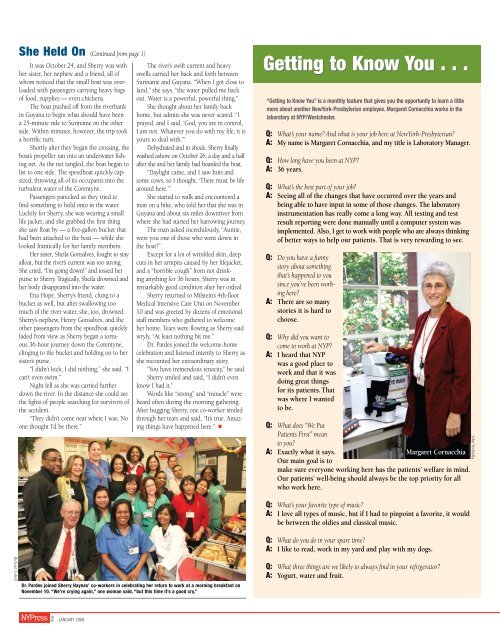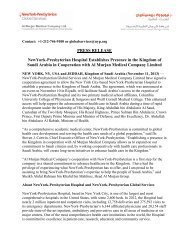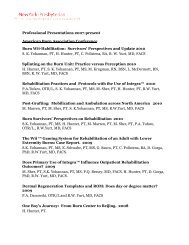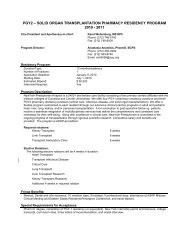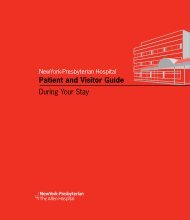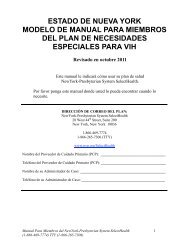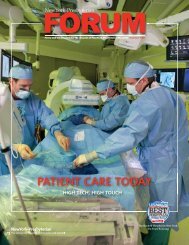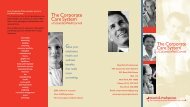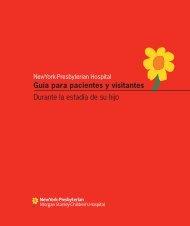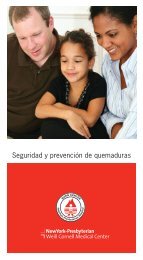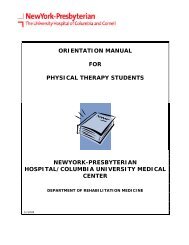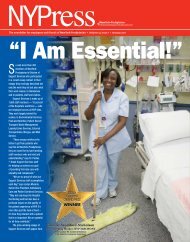January 2009 NYPress - New York Presbyterian Hospital
January 2009 NYPress - New York Presbyterian Hospital
January 2009 NYPress - New York Presbyterian Hospital
Create successful ePaper yourself
Turn your PDF publications into a flip-book with our unique Google optimized e-Paper software.
She Held On<br />
(Continued from page 1)<br />
It was October 24, and Sherry was with<br />
her sister, her nephew and a friend, all of<br />
whom noticed that the small boat was overloaded<br />
with passengers carrying heavy bags<br />
of food, supplies — even chickens.<br />
The boat pushed off from the riverbank<br />
in Guyana to begin what should have been<br />
a 25-minute ride to Suriname on the other<br />
side. Within minutes, however, the trip took<br />
a horrific turn.<br />
Shortly after they began the crossing, the<br />
boat’s propeller ran into an underwater fishing<br />
net. As the net tangled, the boat began to<br />
list to one side. The speedboat quickly capsized,<br />
throwing all of its occupants into the<br />
turbulent water of the Corentyne.<br />
Passengers panicked as they tried to<br />
find something to hold onto in the water.<br />
Luckily for Sherry, she was wearing a small<br />
life jacket, and she grabbed the first thing<br />
she saw float by — a five-gallon bucket that<br />
had been attached to the boat — while she<br />
looked frantically for her family members.<br />
Her sister, Sheila Gonsalves, fought to stay<br />
afloat, but the river’s current was too strong.<br />
She cried, “I’m going down!” and tossed her<br />
purse to Sherry. Tragically, Sheila drowned and<br />
her body disappeared into the water.<br />
Ena Hope, Sherry’s friend, clung to a<br />
bucket as well, but after swallowing too<br />
much of the river water, she, too, drowned.<br />
Sherry’s nephew, Henry Gonsalves, and the<br />
other passengers from the speedboat quickly<br />
faded from view as Sherry began a tortuous<br />
36-hour journey down the Corentyne,<br />
clinging to the bucket and holding on to her<br />
sister’s purse.<br />
“I didn’t kick, I did nothing,” she said. “I<br />
can’t even swim.”<br />
Night fell as she was carried further<br />
down the river. In the distance she could see<br />
the lights of people searching for survivors of<br />
the accident.<br />
“They didn’t come near where I was. No<br />
one thought I’d be there.”<br />
The river’s swift current and heavy<br />
swells carried her back and forth between<br />
Suriname and Guyana. “When I got close to<br />
land,” she says, “the water pulled me back<br />
out. Water is a powerful, powerful thing.”<br />
She thought about her family back<br />
home, but admits she was never scared. “I<br />
prayed, and I said, ‘God, you are in control,<br />
I am not. Whatever you do with my life, it is<br />
yours to deal with.’”<br />
Dehydrated and in shock, Sherry finally<br />
washed ashore on October 26, a day and a half<br />
after she and her family had boarded the boat.<br />
“Daylight came, and I saw huts and<br />
some cows, so I thought, ‘There must be life<br />
around here.’”<br />
She started to walk and encountered a<br />
man on a bike, who told her that she was in<br />
Guyana and about six miles downriver from<br />
where she had started her harrowing journey.<br />
The man asked incredulously, “Auntie,<br />
were you one of those who went down in<br />
the boat”<br />
Except for a lot of wrinkled skin, deep<br />
cuts in her armpits caused by her lifejacket,<br />
and a “horrible cough” from not drinking<br />
anything for 36 hours, Sherry was in<br />
remarkably good condition after her ordeal.<br />
Sherry returned to Milstein’s 4th-floor<br />
Medical Intensive Care Unit on November<br />
10 and was greeted by dozens of emotional<br />
staff members who gathered to welcome<br />
her home. Tears were flowing as Sherry said<br />
wryly, “At least nothing bit me.”<br />
Dr. Pardes joined the welcome-home<br />
celebration and listened intently to Sherry as<br />
she recounted her extraordinary story.<br />
“You have tremendous tenacity,” he said.<br />
Sherry smiled and said, “I didn’t even<br />
know I had it.”<br />
Words like “strong” and “miracle” were<br />
heard often during the morning gathering.<br />
After hugging Sherry, one co-worker smiled<br />
through her tears and said, “It’s true. Amazing<br />
things have happened here.” n<br />
Getting to Know You . . .<br />
“Getting to Know You” is a monthly feature that gives you the opportunity to learn a little<br />
more about another <strong>New</strong><strong>York</strong>-<strong>Presbyterian</strong> employee. Margaret Cornacchia works in the<br />
laboratory at NYP/Westchester.<br />
Q: What’s your name And what is your job here at <strong>New</strong><strong>York</strong>-<strong>Presbyterian</strong><br />
A: My name is Margaret Cornacchia, and my title is Laboratory Manager.<br />
Q: How long have you been at NYP<br />
A: 36 years.<br />
Q: What’s the best part of your job<br />
A: Seeing all of the changes that have occurred over the years and<br />
being able to have input in some of those changes. The laboratory<br />
instrumentation has really come a long way. All testing and test<br />
result reporting were done manually until a computer system was<br />
implemented. Also, I get to work with people who are always thinking<br />
of better ways to help our patients. That is very rewarding to see.<br />
Q: Do you have a funny<br />
story about something<br />
that’s happened to you<br />
since you’ve been working<br />
here<br />
A: There are so many<br />
stories it is hard to<br />
choose.<br />
Q: Why did you want to<br />
come to work at NYP<br />
A: I heard that NYP<br />
was a good place to<br />
work and that it was<br />
doing great things<br />
for its patients. That<br />
was where I wanted<br />
to be.<br />
Q: What does “We Put<br />
Patients First” mean<br />
to you<br />
A: Exactly what it says.<br />
Margaret Cornacchia<br />
Our main goal is to<br />
make sure everyone working here has the patients’ welfare in mind.<br />
Our patients’ well-being should always be the top priority for all<br />
who work here.<br />
John Vechiolla<br />
Q: What’s your favorite type of music<br />
A: I love all types of music, but if I had to pinpoint a favorite, it would<br />
be between the oldies and classical music.<br />
Q: What do you do in your spare time<br />
A: I like to read, work in my yard and play with my dogs.<br />
Richard Lobell<br />
Dr. Pardes joined Sherry Haynes’ co-workers in celebrating her return to work at a morning breakfast on<br />
November 10. “We’re crying again,” one woman said, “but this time it’s a good cry.”<br />
Q: What three things are we likely to always find in your refrigerator<br />
A: Yogurt, water and fruit.<br />
ress<br />
2 JANUARY <strong>2009</strong>


